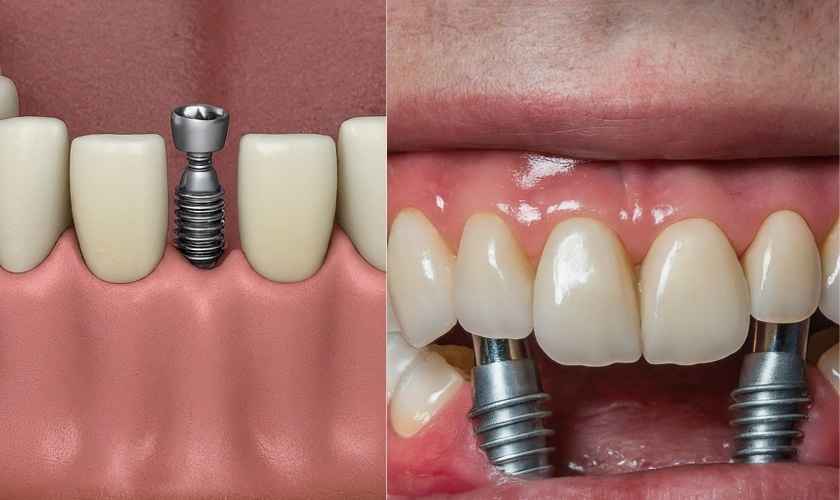7 Easy Facts About Dental Sense Shown
7 Easy Facts About Dental Sense Shown
Blog Article
Examine This Report about Dental Sense
Table of ContentsThe 6-Second Trick For Dental Sense6 Easy Facts About Dental Sense DescribedLittle Known Questions About Dental Sense.Not known Incorrect Statements About Dental Sense
are clinical gadgets operatively dental implanted right into the jaw to recover an individual's ability to chew or their look. They provide support for artificial (fake) teeth, such as crowns, bridges, or dentures. When a tooth is lost as a result of injury or illness, a person can experience problems such as rapid bone loss, faulty speech, or changes to eating patterns that cause discomfort.Dental implant systems are composed of a dental implant body and oral implant joint and may also include an abutment fixation screw. Dental implant vs bridge. The dental implant body is operatively placed in the jawbone in location of the tooth's root. The oral implant joint is normally connected to the implant body by the joint addiction screw and expands through periodontals right into the mouth to sustain the affixed synthetic teeth
(https://gravatar.com/futuristiccreativelyc881a796d5)Framework of The Oral Implant System picking oral implants, talk to your oral provider about the possible advantages and risks, and whether you are a candidate for the procedure. Things to consider: Your overall health and wellness is an essential factor in determining whether you are a good prospect for dental implants, for how long it will certainly require to recover, and for how long the implant may remain in area.
Smoking cigarettes might influence the recovery procedure and lower the long-lasting success of the implant. The healing process for the dental implant body may take a number of months or longer, during which time you normally have a temporary abutment in location of the tooth. the oral implant treatment: Thoroughly comply with the dental health guidelines offered to you by your oral supplier.
The Greatest Guide To Dental Sense
Implant failure can lead to the demand for an additional surgery to take care of or replace the dental implant system. Brings back the capacity to chew Brings back cosmetic look Aids maintain the jawbone from shrinking due to bone loss Protects the wellness of the bordering bone and periodontals Aids maintain nearby (neighboring) teeth steady Enhances top quality of life Damage to surrounding natural teeth during implant positioning Injury to the surrounding cells throughout surgery, such as sinus opening Injury during surgery (as an example, crack of surrounding jawbone) Poor function, such as seeming like the teeth do not attack together normally A feeling that the tooth is loose or twisting in position resulting from an abutment screw loosening up Implant body failing (looseness of the dental implant body) because of systemic infection, which might be most likely in individuals with uncontrolled diabetes mellitus due to local infection in bone and periodontals sustaining the dental implant body as a result of delayed recovery, which may be much more most likely in people that smoke Problem cleansing the periodontals around the implant, resulting in poor oral hygiene Untreated gum illness Post-surgical tingling because of nerve impingement or damage Constantly alert healthcare carriers and imaging professionals that you have oral implants before any type of magnetic resonance imaging (MRI) or x-ray procedures.
FDA is not knowledgeable about any unfavorable occasions reported for MRI or x-ray procedures with oral implants. Dental implants systems are typically made of products that comply with international agreement standards of the International Company for Standardization (ISO) or ASTM International. These standards have details of what makes a risk-free material.

An oral implant is a structure that changes a missing out on tooth. With screw-like devices, the surgeon inserts an implant into the jawbone, and it functions as a support for a man-made tooth, called a crown. A device called a joint links the fabricated tooth to the dental implant. The crown is custom-made to fit the individual's mouth and match the color of their teeth.
Dental Sense Things To Know Before You Buy
Some individuals are not qualified for oral implant surgical procedure. It is for dental surgeons to run on people with: acute illnessuncontrollable metabolic diseasebone or soft cells condition or infectionIf these problems are solved, a person can have the surgical procedure. In, oral cosmetic surgeons avoid from operating people with: If people with any one of the above undergo dental implant surgical procedure, there is a greater danger of the implant failing.

Oral dental implant surgical procedure is a tailored process. It's not the very same for everybody. However the following provides a general introduction of what you can expect your dental practitioner, dental surgeon, periodontist or prosthodontist to do: Put the dental implant surgically. Give you time to recover. Attach the message and last crown, bridge or denture.
Next, your cosmetic surgeon will thoroughly position the dental implant right into your jaw. Lastly, your cosmetic surgeon will certainly reposition your gums and shut the cut with from this source stitches. If your implant is near the front of your mouth, your dental practitioner will make a temporary tooth for you to use up until you recover. By doing this, you will not have a gap in your smile while you recoup.
4 Easy Facts About Dental Sense Described
Your service provider can inform you what to anticipate in your circumstance. Throughout the healing stage, your jawbone needs to fuse to the oral implant. This procedure, called osseointegration, is important for stability and long-term success. This procedure can take anywhere from 3 to 9 months. In many cases, it may take much longer.
Once your implant heals, your dental professional can attach the joint (small adapter post) and your last reconstruction (crown, bridge or denture). This usually takes regarding one hour to finish and may need a 2nd minor surgical treatment. You shouldn't feel any type of pain throughout your dental implant procedure because your copyright will utilize drug to numb your gum tissues.
Report this page